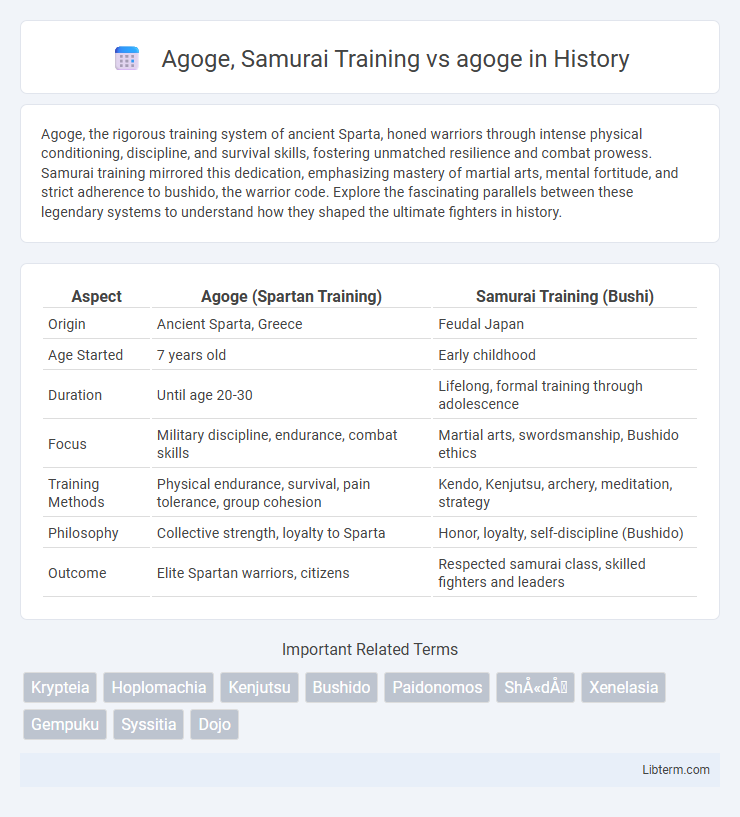Agoge, the rigorous training system of ancient Sparta, honed warriors through intense physical conditioning, discipline, and survival skills, fostering unmatched resilience and combat prowess. Samurai training mirrored this dedication, emphasizing mastery of martial arts, mental fortitude, and strict adherence to bushido, the warrior code. Explore the fascinating parallels between these legendary systems to understand how they shaped the ultimate fighters in history.
Table of Comparison
| Aspect | Agoge (Spartan Training) | Samurai Training (Bushi) |
|---|---|---|
| Origin | Ancient Sparta, Greece | Feudal Japan |
| Age Started | 7 years old | Early childhood |
| Duration | Until age 20-30 | Lifelong, formal training through adolescence |
| Focus | Military discipline, endurance, combat skills | Martial arts, swordsmanship, Bushido ethics |
| Training Methods | Physical endurance, survival, pain tolerance, group cohesion | Kendo, Kenjutsu, archery, meditation, strategy |
| Philosophy | Collective strength, loyalty to Sparta | Honor, loyalty, self-discipline (Bushido) |
| Outcome | Elite Spartan warriors, citizens | Respected samurai class, skilled fighters and leaders |
Understanding the Agoge: The Spartan Training System
The Agoge, the rigorous Spartan training system, emphasized discipline, endurance, and combat skills to produce elite warriors capable of defending Sparta. Unlike the Samurai training, which integrated bushido ethics and individual mastery, the Agoge focused on collective loyalty, physical toughness, and survival skills from a young age. This Spartan method fostered resilience and unity, shaping soldiers who were both physically formidable and socially cohesive in battle.
The Warrior Code: Foundations of Samurai Training
The Warrior Code, or Bushido, forms the core foundation of Samurai training, emphasizing virtues like honor, loyalty, and discipline. Agoge, the Spartan training system, prioritizes endurance, combat skills, and communal loyalty but lacks the philosophical depth seen in Bushido. Samurai training integrates martial arts with ethical conduct, creating a holistic warrior ideal rooted in spiritual and moral principles.
Daily Regimens: Spartan Discipline vs. Samurai Routine
The Agoge, the rigorous Spartan training system, emphasized daily physical endurance, combat drills, and communal living to instill discipline, resilience, and obedience from a young age. Samurai training focused on mastering martial arts such as kenjutsu, archery, and horseback riding, combined with meditation and ethics based on Bushido to cultivate mental fortitude and honor. Spartan regimens prioritized relentless physical hardship and group cohesion, whereas Samurai routines balanced martial skill development with spiritual and moral education.
Physical Conditioning: Strength and Endurance in Both Cultures
Agoge training emphasized rigorous physical conditioning through endurance drills, strength-building exercises, and combat simulations, aiming to develop resilient warriors for Spartan society. Samurai training also prioritized physical conditioning but balanced strength with agility, incorporating martial arts, swordsmanship, and stamina exercises essential for battlefield versatility. Both cultures valued disciplined strength and endurance, though Agoge focused on collective toughness while samurai conditioning stressed individual skill and flexibility.
Weapons Mastery: Spartan Spears vs. Samurai Swords
Spartan Agoge training emphasized mastery of the dory spear, designed for thrusting in phalanx warfare with a bronze or iron tip and wooden shaft, demanding precision and strength in formation tactics. Samurai training focused extensively on the katana, a curved, single-edged sword renowned for its sharpness and cutting ability, requiring fluid swordsmanship techniques and individual combat skills. While Spartans prioritized disciplined spear handling for collective battle effectiveness, samurai honed swordsmanship for versatile, close-quarters duels and swift, decisive strikes.
Mental Toughness: Emotional Training in Sparta and Japan
The Agoge in Sparta emphasized rigorous emotional control and resilience, shaping warriors through intense mental toughness exercises designed to endure pain, fear, and hardship. Samurai training, rooted in Bushido, cultivated emotional discipline by fostering loyalty, honor, and self-restraint, balancing stoicism with measured emotional expression. Both systems developed exceptional mental fortitude, enabling warriors to face psychological and physical challenges with unwavering resolve.
Socialization and Loyalty: Brotherhood in Agoge and Bushido
Agoge training fostered intense socialization and loyalty through rigorous communal living and shared hardships, cultivating a brotherhood essential for Spartan military unity. Similarly, Samurai training emphasized Bushido, a code that instilled deep loyalty and honor among warriors, creating bonds of trust within their clans. Both systems used structured discipline and ethical frameworks to strengthen social cohesion and collective identity in their respective cultures.
Age and Initiation: Entry into Warrior Training
Agoge training began at age seven, marking early initiation into Spartan military discipline with rigorous physical, social, and survival skills developed over many years. In contrast, Samurai training often started in childhood but formal initiation typically occurred during adolescence, focusing on martial arts, ethics, and Bushido philosophy. Both systems emphasized early age entry to instill warrior values and ensure long-term martial proficiency.
Cultural Impacts: Legacy of Spartan and Samurai Methods
The Agoge, the rigorous training system of Spartan youth, emphasized discipline, endurance, and loyalty to the polis, shaping a warrior culture that valued communal strength and sacrifice. In contrast, Samurai training centered on Bushido, cultivating honor, skill in martial arts, and loyalty to one's daimyo, deeply influencing Japanese societal values and aesthetics. Both methods left enduring cultural legacies, with Spartan ideals inspiring modern military discipline and citizenship, while Samurai ethics continue to impact Japanese art, philosophy, and social hierarchy.
Samurai Training vs. Agoge: Comparative Analysis and Influence
Samurai training emphasized rigorous martial discipline, bushido ethics, and mastery of weaponry, focusing on mental fortitude and loyalty, contrasting with the Agoge's communal Spartan education centered on physical endurance, combat skills, and unwavering obedience to the state. While the Agoge developed elite warriors through state-controlled training from childhood, Samurai training combined family heritage, philosophical teachings, and battlefield experience to cultivate individual honor and social status. Both systems influenced military traditions by instilling resilience and discipline but diverged in their cultural contexts and educational structures.
Agoge, Samurai Training Infographic

 libterm.com
libterm.com